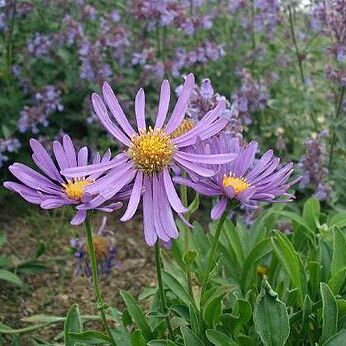Perennial herbs, rarely annuals or shrubs. Lvs alternate or all basal, simple, entire to toothed, rarely more deeply incised. Capitula 1-numerous, mostly in cymes or panicles. Involucral bracts in 2-several rows, equal or imbricate, usually herbaceous toward apices, sometimes wholly herbaceous or chartaceous. Receptacle flat or convex; scales 0. Outer florets usually ♀, rarely sterile, usually ligulate, very rarely filiform, few to numerous in 1-2 rows; ligules white to red, purple or blue. Inner florets ☿, tubular, few to numerous. Achenes all similar, obovoid to cylindric, compressed, glabrous or hairy and sometimes glandular, often 4-5-ribbed; pappus of scabrid hairs in 1 row, sometimes with an outer row of short hairs or scales.
Herbs with tuberous roots or woody rhizomes, rarely annual herbs or small shrubs. Leaves alternate, entire or dentate-pinnatifid. Capitula heterogamous, usually radiate, few–many-flowered, solitary or in corymbs; phyllaries 3–4(–5)-seriate, imbricate, the outer shorter than the inner. Ray florets female, usually 1-seriate, sometimes with staminodes; central flowers hermaphrodite, tubular, 5-lobed, anthers linear, obtuse at the base, with a lanceolate appendage at the apex, style bifid with linear branches. Achenes ellipsoid or obovoid, slightly compressed, pubescent and glandular; pappus of many usually unequal bristles, rarely double with an outer row of scale-like bristles.

